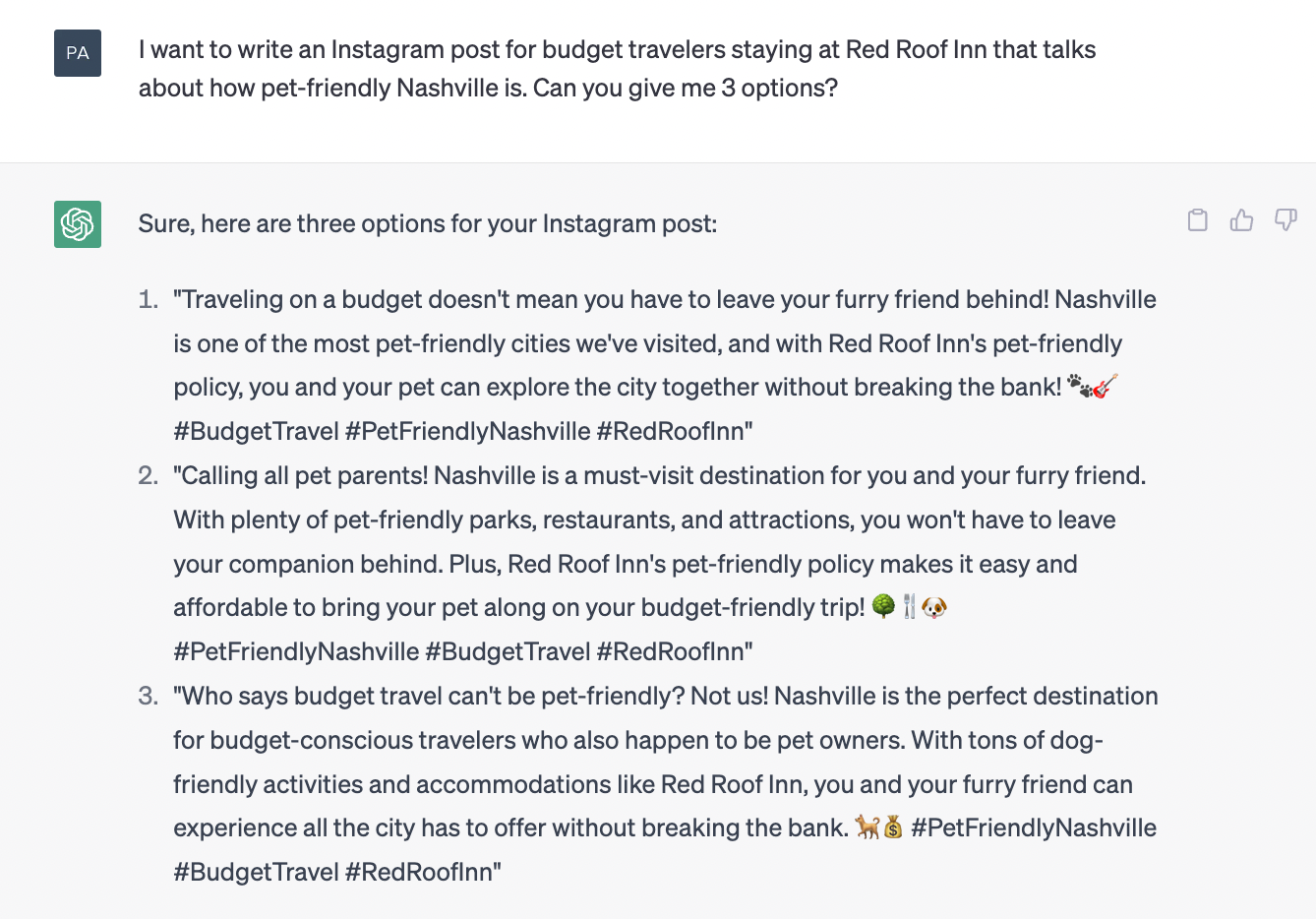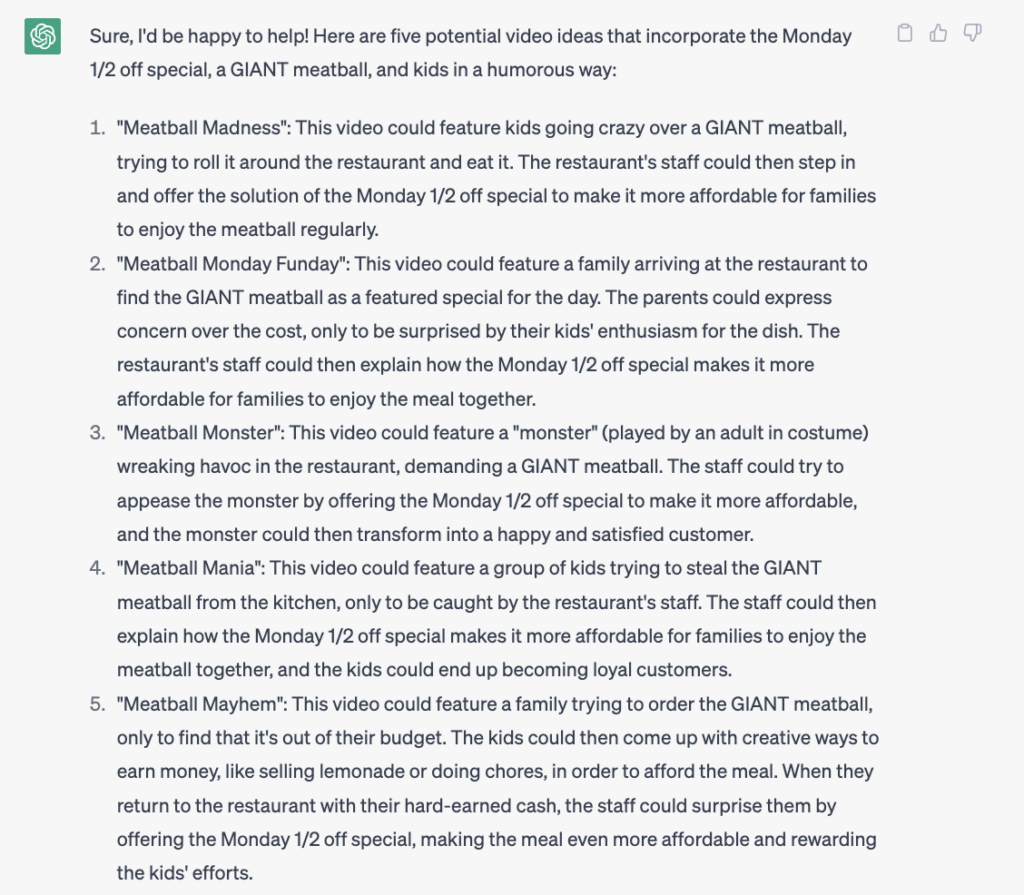Paula Ersly is a Head of Social Strategy at Acadia.
Is ChatGPT a friend or foe? The AI tool has consumed the attention of companies eager to find out how it can be used to save time, create more efficiencies, and maybe even cut corners. That can be a chilling prospect for copywriters, marketers, and other creatives who are unsure whether or not their role has a future with ChatGPT around.
It’s an understandable concern. But using AI to drum up copy isn’t lazy – it’s an advantage that creatives themselves can leverage. Agencies that view AI as a capability that they can add to their tool belts will find themselves staying ahead of the curve and offering a more competitive pitch to their clients. The key is to understand how ChatGPT and other AI platforms can be used in a way that frees up the best thinkers to do what they do best. It’s not cheating to use AI to generate starter-block ideas, jumpstart inspiration or comb the Internet on your behalf – it’s savvy. Shouldn’t your team be tasked with creating and refining concepts, and coming up with what ChatGPT can’t, while the AI tool does the manual work that drains billable hours? And at the pace, the industry is moving, those who don’t take the time now to wield AI’s power are at risk of being left behind.
Think of it this way: AI has the ability to level the playing field for smaller upstarts (the Davids) with the Fortune 500 companies (the Goliaths) that typically have more resources and bandwidth at their fingertips and can compete in a way that smaller companies can’t. In the same way that social media democratized marketing, making it as easy for a mom-and-pop burger shop to write a viral tweet as Wendy’s, AI is a tool that can do the manual work of a large team. All you need is to know how to use it in a way that will set your company apart.
The social team at Acadia has been working to master AI to not only up our social media game but to also make our day-to-day lives easier. Here’s what we’ve found.
1. Struggling with writer’s block? ChatGPT can help. If you’re having a hard time coming up with a new hook for social or a fresh way to talk about a product you’ve been writing about for months, ChatGPT can quickly generate lists of copy options, including taglines, hashtags, and descriptors that will get you back in the groove. It’s not replacing copywriters, but rather it’s batch creation at its best. ChatGPT may spark ideas, but it’s not going to finesse the copy like a real person who knows the product can. Be sure to edit any ChatGPT copy to make sure it matches your brand’s voice.

Source: ChatGPT example
To get the most out of ChatGPT as a basic framework for a piece of copy, be sure to start with as specific a prompt as possible, rather than a vague generalization. The more details you give (“Write a product description for a blue T-shirt” versus “Write a product description for a sophisticated menswear brand for a light-blue, crew neck T-shirt made from 100% cotton that would be a perfect layering piece or workout shirt”), the more relevant the answer will be. And don’t just run with the first response. Use it as a way to learn what details are missing, and keep adding to it to get better answers. If you’re looking for more information, you can feed in updates that ChatGPT will respond to in real time – that’s what sets generative AI apart from past chatbots. Talk to it like you would if you were giving notes to a copywriter or a designer, and see how much nuance it understands. It’s likely more than you think!
2. Use ChatGPT as your copy editor. The strength of a tool like ChatGPT is that it’s not as prone to human error. You can enter copy you’ve written into ChatGPT and ask it to edit the text for you by cutting down on excess words or perfecting your grammar. This is a use case best used in a pinch – say you’re trying to quickly convert a lengthy blog post or newsletter into a social post. You’ve done the bulk of the work, now let ChatGPT spruce up and double-check the final product.
That said, be sure to fact-check ChatGPT’s work. Generative AI can turn up misinformation – one of the reasons alarm bells have rung for some – and the tools are trained on information up to 2021 or 2022, meaning things might have changed without ChatGPT catching on. Don’t let ChatGPT turn into autopilot; keep a watchful eye to make sure you’re using it to be efficient, but not cutting corners.
3. Spark big ideas by generating a starting point. Sometimes if our team is stuck on a video concept, we ask ChatGPT to write a few script options. They’re never going to be 100% right. With more use of ChatGPT, you’ll start to recognize its limitations along with its strengths. And in asking it to generate a script for a video concept, it can spark a fresh idea or new approach that gets your team closer to the final product.
There are also ways to make ChatGPT work better for you. You can provide past examples of work that you want it to study and understand so it can generate more content like it. Say “Hey ChatGPT, I’m going to give you 10 Instagram posts I wrote for Client X. Can you study them and then write a new post about Topic Y in their voice?” You shouldn’t shy away from the emotional values or proposition of the brand in your prompts – this is what will tailor the tool to your needs.


Source: ChatGPT example
4. Quickly convert text to speech with audio AI. AI isn’t limited to text functions: audio tools can translate scripts into spoken word in a matter of minutes. These tools have become more available through video editing software or as standalone services, such as Voicebooking AI, that include a library of voices to choose from to tailor to your specific project. When you provide a prompt or script, choose the voice you want to use and the AI tool will speak the words right back to you. From there, you can tweak the audio for pitch, tone and speed to get exactly what you’re looking for. This is one corner of AI that has really blown away the Acadia team by coming a long way in a short time. When you get it exactly right, it sounds like a recording by a human. In practice, this has meant we can quickly draw up voice overs for brand work that feels and sounds right while bypassing the lengthy casting and briefing process.
This way, we can hop on trends quickly (take TikTok for example, where speed pays off and AI voice overs are readily available and commonly used by creators) as well as act on last-minute requests.
5. Create stunning visuals and easily source images. Not just text, not just audio – generative AI can also be a massive help in the image department. If you’ve ever spent hours scouring Pinterest looking for dozens of images that can communicate a concept in a deck or a shotlist, meet Midjourney. Midjourney is one of many emerging AI image tools that can create images based on prompts. Dall-E and Adobe Firefly are a few others. You can tell these tools the image you have in your head – “fashion-style photo of a woman in front of a French cafe shot on Kodak Gold 200 16:9 fashion photography jewelry” – and it will bring that image to life instantly. Midjourney and other AI image tools can conjure different art styles, colors, themes, camera angles and types to create any imagery you can think of, with multiple options per prompt to choose from.
This has quickly become a go-to way for our team to turn words and concepts into images that we can then share with clients. Sometimes a picture is worth more than words – but we’ve only just begun our exploration here. What successes have you seen with image generation on your teams?

Source: MidJourney
Original prompt for image: fashion style photo of a woman in front of a french cafe shot on Kodak Gold 200 16:9 fashion photography jewelry
As you can see, generative AI – be it in the form of text, audio, or images – is an assistant, not a replacement. The end goal is for this technology to free up time so you can work on more valuable parts of a project that a bot could never do, like nailing a client pitch or dreaming up the next big campaign concept. All AI requires deft human touch, and good output is only possible with good input. Take the time to apply what you know about your brand, its voice and its direction to get the best result possible. It could quickly become your biggest asset, and you don’t want to be left behind.
If you want to get started, here’s a short list of our favorite tools so far:
- ChatGPT (Text generation)
- Midjourney, Adobe Firefly (Image generation)
- Canva AI Editor (Smart image editing)
- Voicebooking AI (Audio)
